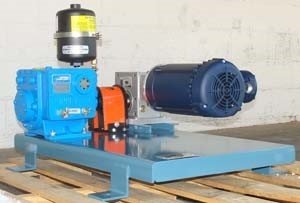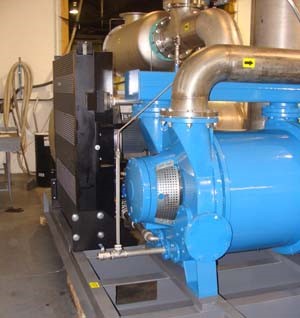
Degasification refers to the process of removing dissolved gases from water or aqueous solutions. According to Henry’s Law, the amount of a dissolved gas with a liquid corresponds proportionally with its partial pressure. This means that putting a solution under reduced pressure will make the dissolved gas less soluble and easier to separate.
The degassing process is most commonly used for the removal of Oxygen, Carbon Dioxide, and Nitrogen from water. As the water runs through a degasification tower, equipped with trays or packing for maximum surface area exposure, pressure is reduced for better gas removal. Degasification is used with plant cooling systems in industries such as power, semiconductor, chemical, and pharmaceutical to eliminate the formation of gas bubbles, which can interfere with heat transfer or cause corrosion.
Considerations must be made in selecting the right vacuum pump for degasification. Since both gases and liquids are involved in the degassing process, it is important to specify a pump that is able to manage a degree of liquid carryover in a process upset. It must also be able to pump both gases and entrained vapors from a liquid. Considering that various types of liquids and gases will be handled, the pump must be able to manage corrosive, toxic, and flammable substances. It should have compatible materials of construction including the elastomers, as well as proper electrical components such as motors and safety devices. Tuthill Liquid Ring Pumps meet these requirements. Internal lubrication is not needed for the Liquid Ring, which can run on most liquids including water, low viscosity oil, or other solvents that are compatible with its materials and process.

Liquid Ring Pumps are engineered to handle liquid slugs from process upsets or an ongoing flow of liquid condensate. Depending on the needs of the application, it can perform as both a vacuum pump for non-condensing substances and a direct contact condenser for vapors, which increases its overall pumping capacity. A highly reliable and durable mechanical pump, the Liquid Ring features a simplistic one rotating shaft design. It is also available in 316 stainless steel for greater corrosion resistance to process liquid waste.
The Tuthill Rotary Screw Dry Pump can handle a degree of liquid carryover, but performs best when kept dry. Like the Liquid Ring, this pump does not require internal lubrication. The Dry Pump contains no liquid within its pumping chamber, so it is not limited by the vapor pressure of the liquid and can achieve lower pressures without producing process contaminated waste products. Condensable vapors are managed by keeping them at a higher temperature in the vapor phase as they move from suction to discharge. They can then be condensed in an after-condenser. This Tuthill vacuum pump is available with optional protective coating.
For assistance in selecting a vacuum pump for your degassing process, contact the specialists at Gasho.

